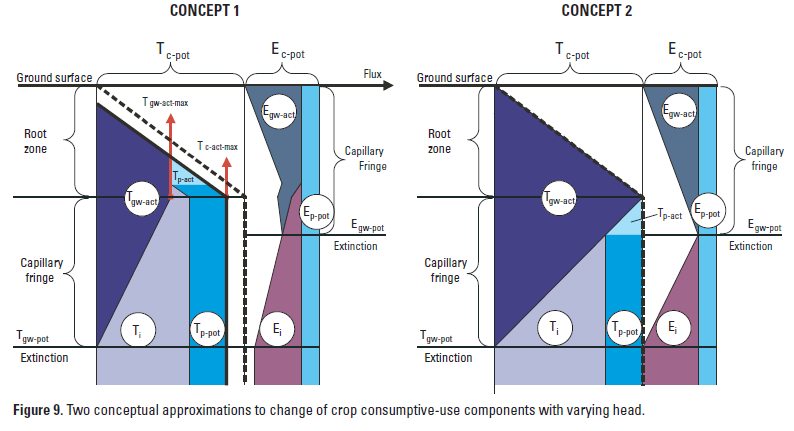Crop Consumptive-Use Flag |
Crop Consumptive-Use Flag |
This pane is a subpane of the FMP: Farm Process pane on the MODFLOW Packages and Programs dialog box.
The Crop Consumptive-Use Flag (ICCFL) specifies both which crop-consumptive use concept is to be applied and the linkage with the UZF package.
The Farm Process has two crop-consumptive use concepts named Concept 1 and Concept 2. Concept 2 is a simplification of Concept 1. Both describe how much transpiration occurs when the groundwater level is above the bottom of the root zone. The diagram below (Schmid and others (2006) p. 16) illustrates how the components of transpiration and evaporation vary with head. In the diagram, the width of the colored regions represent how much transpiration and evaporation will occur when the groundwater is at different levels. If the groundwater level is low enough, all the transpiration and evaporation comes from irrigation and precipitation and none comes from groundwater. At higher groundwater levels, transpiration from groundwater increases. At some point irrigation is no longer required and all transpiration comes from groundwater or precipitation. However, when the groundwater level gets high enough, transpiration decreases. This is because some of the soil around the roots becomes saturated and the roots are unable to function under anoxic conditions.
In Concept 1, the user specifies four pressure heads on the Crops pane of the Farm Crop Properties dialog box:
1.the pressure head at or above which transpiration is zero because of anoxia,
2.a lower pressure head at which transpiration is at a maximum but at which any higher pressure head will start to cause transpiration to decrease because of anoxia,
3.a lower pressure head at which transpiration is still at a maximum but at which any lower pressure head will start to cause transpiration to decrease because of wilting, and
4.the pressure head at or below which transpiration drops to zero because of wilting.
The pressure heads can be either positive or negative. The Farm process uses these pressure heads together with some soil properties to calculate a pressure head distribution over the total root zone in order to determine the amount of transpiration supplied by groundwater. The total transpiration never quite reaches the maximum potential transpiration when Concept 1 is used.
In Concept 2, it is assumed that when the groundwater level is at the bottom of the root zone all of the transpiration comes from groundwater and the amount of transpiration is equal to the potential transpiration.

(All of the following have units of [L/T]·[L2].)
Ec-pot = potential evaporative consumptive use per cell
Egw-act = actual evaporation uptake from ground water per cell
Ei = evaporation requirement from irrigation
Ep-pot = potential evaporation from precipitation per cell
Tc-act-max = maximum actual transpiratory consumptive use per cell
Tc-pot = potential transpiration from precipitation per cell
Ti = transpiration requirement from irrigation per cell
Tgw-act = actual transpiration uptake from ground water per cell
Tgw-act-max = maximum actual transpiration uptake from ground water per cell
Tp-act = actual transpiration from precipitation per cell
Tp-pot = potential transpiration from precipitation per cell
If the option to link the Farm Process to the UZF package is used, net recharge from farms will be passed to the UZF package as infiltration. Therefore in the areas where recharge from farms will be present the UZF infiltration rate should be set to zero and either evapotranspiration should not be simulated in the UZF package or the Evapotranspiration Demand should be zero where there are farms. Otherwise, there could be a double accounting of evapotranspiration.